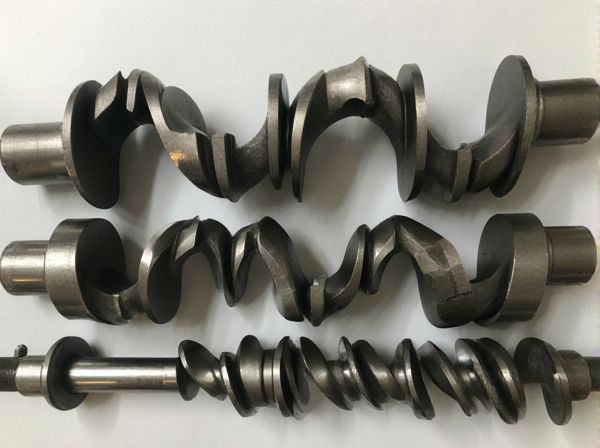
Photo illustration: Knife-edged crankshaft vs Standard-edged crankshaft
Knife-edged crankshafts feature tapered, sharp edges that reduce windage and rotational resistance, enhancing engine efficiency and performance. Standard-edged crankshafts have flat or rounded edges that offer greater structural strength but may increase friction and drag at high RPMs. Choosing the right crankshaft design can optimize Your engine's balance between durability and speed.
Table of Comparison
| Feature | Knife-Edged Crankshaft | Standard-Edged Crankshaft |
|---|---|---|
| Design | Thin, sharp-edged counterweights | Thick, rounded counterweights |
| Weight | Lightweight for reduced rotating mass | Heavier for added durability |
| Performance | Improved engine response; higher RPM capability | Stable performance; suited for standard driving |
| Durability | Less robust; higher stress on counterweights | More durable; better fatigue resistance |
| Cost | Usually more expensive due to precision machining | Cost-effective manufacturing |
| Common Use | High-performance and racing engines | Everyday passenger vehicles |
Introduction to Crankshaft Designs
Knife-edged crankshafts feature tapered, sharp edges designed to reduce air resistance and improve engine efficiency by minimizing drag. Standard-edged crankshafts have a more rounded or flat profile, prioritizing manufacturing simplicity and durability over aerodynamic performance. The choice between these designs impacts engine balance, RPM capability, and overall power output, essential factors in high-performance vs. standard engines.
What Is a Knife-Edged Crankshaft?
A knife-edged crankshaft features tapered, sharp-edged counterweights designed to reduce aerodynamic drag and rotational mass, enhancing engine performance and responsiveness. This design improves the crankshaft's ability to maintain higher rotational speeds with less effort compared to a standard-edged crankshaft, which has bulkier, rounded counterweights. Used predominantly in high-performance and racing engines, the knife-edged crankshaft optimizes balance while minimizing inertia to support quicker acceleration and smoother operation.
Features of Standard-Edged Crankshafts
Standard-edged crankshafts feature a broader surface area and rounded edges that enhance durability and reduce stress concentrations under high-load conditions. These crankshafts provide improved fatigue resistance due to their smoother transitions between the crank web and journal surfaces. Their design supports reliable performance in conventional internal combustion engines where consistent strength and longevity are essential.
Aerodynamics and Oil Control in Crankshafts
Knife-edged crankshafts feature sharply tapered counterweights that reduce aerodynamic drag within the engine, enhancing high-RPM performance by minimizing windage losses. Standard-edged crankshafts have bulkier counterweights, increasing air resistance and consequently higher oil churn, which can impair oil control and increase parasitic power loss. Improved aerodynamics of knife-edged designs also promote better oil separation and circulation, optimizing lubrication and reducing oil consumption compared to standard crankshafts.
Performance Gains: Knife-Edged vs Standard-Edged
Knife-edged crankshafts improve performance by reducing rotational mass and friction compared to standard-edged crankshafts, enabling quicker acceleration and higher RPM capabilities. The streamlined edges of knife-edged designs facilitate smoother oil flow and enhanced heat dissipation, contributing to increased engine efficiency and longevity. In competitive motorsports and high-performance applications, knife-edged crankshafts offer measurable gains in throttle response and overall power output over conventional standard-edge counterparts.
Impact on Engine Efficiency and Power
Knife-edged crankshafts reduce windage losses by minimizing air resistance during rotation, leading to improved engine efficiency and increased power output compared to standard-edged crankshafts. The streamlined design enhances oil control and reduces parasitic drag, which contributes to smoother engine operation and higher RPM capabilities. Engines equipped with knife-edged crankshafts typically demonstrate better fuel economy and responsiveness due to optimized rotational dynamics.
Durability and Longevity Considerations
Knife-edged crankshafts offer enhanced durability due to reduced stress concentrations along the edges, allowing for smoother stress distribution and less material fatigue over time. Standard-edged crankshafts, while easier to manufacture, often experience higher localized stress points that can lead to quicker wear and potential cracking under heavy loads. In terms of longevity, knife-edged designs typically exhibit superior resistance to fatigue and improved service life in high-performance or heavy-duty engines.
Cost Differences and Manufacturing Challenges
Knife-edged crankshafts typically incur higher manufacturing costs due to the precision machining and advanced materials required to maintain structural integrity and durability under stress. Standard-edged crankshafts benefit from simpler production processes, resulting in lower fabrication expenses and easier quality control. The complexity of crafting knife-edged designs often leads to increased tooling wear and longer machining times, contributing to overall cost differences compared to standard-edged crankshafts.
Best Applications for Each Crankshaft Type
Knife-edged crankshafts excel in high-performance racing engines where reduced windage and improved throttle response are critical, making them ideal for drag racing and lightweight sports cars. Standard-edged crankshafts offer robust durability and smoother operation, well-suited for daily driving vehicles, heavy-duty trucks, and engines requiring long-term reliability. Selecting between the two depends on the specific demands of the application, balancing performance needs against engine longevity and maintenance intervals.
Conclusion: Choosing the Right Crankshaft for Your Engine
Knife-edged crankshafts offer enhanced aerodynamic efficiency and reduced rotational inertia, leading to improved engine responsiveness and higher RPM capabilities. Standard-edged crankshafts provide robust durability and are typically more cost-effective, making them suitable for everyday driving and heavy-duty applications. Selecting the right crankshaft depends on prioritizing performance benefits versus longevity and budget constraints, aligning with the engine's intended use and operating conditions.
 caratoz.com
caratoz.com